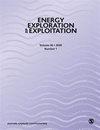流经火箭发动机喷嘴的三混合纳米流体:数值求解与不可逆分析
IF 1.6
4区 工程技术
Q4 ENERGY & FUELS
引用次数: 0
摘要
研究问题:该研究调查了火箭发动机再生冷却通道内的热传递和熵产生过程。调查的主要重点是使用分散在作为基础流体的水中的纳米颗粒(二氧化钛、氧化铜和二氧化铝)。在冷却系统的背景下,该研究试图了解这些纳米流体对水热性能和熵产生的影响。研究方法:该研究通过相似性转换,将控制方程简化为非二维形式。我们使用射击技术和还原库塔-4(RK-4)数值方法求解改变后的方程。我们特别关注努塞尔特数和熵生成数,并通过图形表示突出了影响水热性能的重要参数。影响:研究结果强调了水基纳米流体(尤其是二氧化钛 (TiO2))作为火箭发动机冷却剂的性能。这项工作还阐明了不同参数如何影响系统中的熵产生。这项研究的重要性在于,它可用于改进航空工程中再生冷却系统的设计,从而提高整体性能和效率。未来工作:对流体特性和纳米粒子浓度的操作进行更多研究,以进一步提高火箭发动机的冷却效率。还可以研究其他纳米粒子材料及其对熵生成和热传输的影响。此外,数值结果的实验验证可为建议方法的实际使用和验证提供重要信息。本文章由计算机程序翻译,如有差异,请以英文原文为准。
Trihybrid nanofluid flow through nozzle of a rocket engine: Numerical solution and irreversibility analysis
Research Problem: The research investigates the process of heat transmission and the production of entropy within the regenerative cooling channel of a rocket engine. The primary focus of the investigation is on the use of nanoparticles (titanium dioxide, copper oxide, and alumina dioxide) that are dispersed in water as the base fluid. Within the context of the cooling system, the research endeavors to gain an understanding of the influence that these nanofluids have on hydrothermal performance and entropy production. Methodology: The investigation transforms similarity to reduce the governing equations to a non-dimensional form. We solve the altered equations using a shooting technique and the reduced Kutta-4 (RK-4) numerical method. With a particular focus on the Nusselt number and entropy generation number, graphic representations highlight the important parameters affecting hydrothermal performance. Implications: The results emphasize how well water-based nanofluids work, especially titanium dioxide (TiO2 ), as a coolant in rocket engines. The work also clarifies how different parameters affect the entropy creation in the system. The importance of this study is in its possible use to improve the design of regenerative cooling systems in aeronautical engineering, therefore raising overall performance and efficiency. Future work: More investigation into the manipulation of fluid characteristics and nanoparticle concentrations should improve rocket engine cooling efficiency even more. Alternative nanoparticle materials and their impact on entropy generation and heat transport might also be investigated. Moreover, experimental validation of the numerical results can offer important information for the practical use and validation of the suggested approaches.
求助全文
通过发布文献求助,成功后即可免费获取论文全文。
去求助
来源期刊

Energy Exploration & Exploitation
工程技术-能源与燃料
CiteScore
5.40
自引率
3.70%
发文量
78
审稿时长
3.9 months
期刊介绍:
Energy Exploration & Exploitation is a peer-reviewed, open access journal that provides up-to-date, informative reviews and original articles on important issues in the exploration, exploitation, use and economics of the world’s energy resources.
 求助内容:
求助内容: 应助结果提醒方式:
应助结果提醒方式:


